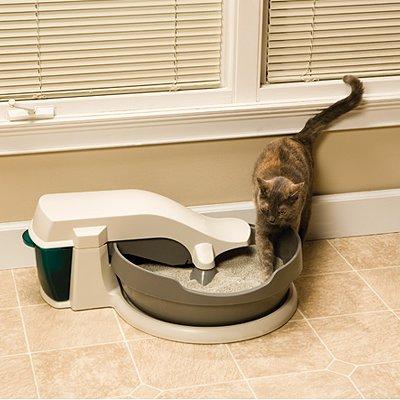
January 13, 2013
PetSafe® Expert
Roslyn McKenna
Solve Your Cat’s Litter Box Problem
By Roslyn McKenna, PetSafe® Web Content Specialist
Cats are some of the easiest pets to care for: they don’t need baths, potty breaks, or expensive toys (especially when they’ve got cardboard boxes to play with). But even cats can be difficult to live with, especially if they’ve developed a problem with the litter box. Most cat owners have faced this frustrating problem before, and can attest to how difficult it can be to solve. I’ve dealt with this problem with my own cats, so I wanted to share how I helped my cats stop using the carpet as a litterbox.
Diagnosing the Problem

Having multiple cats can make it hard to figure out who’s behind those pee spots.
In multiple cat households, the first step is figuring out who’s doing it. Separate your cats one at a time until you find the offender. You can keep each one in a separate room with their own litter box, or separate them one at a time. Check the room and litter box every day for pee spots. Repeat with each cat; you might have multiple offenders. If your cat doesn’t have any accidents when isolated, one of your other cats might be bullying the others, making your cat afraid to pee when other cats are nearby.
The next step is ruling out medical issues. Take the cat(s) to the vet to check for urinary tract infections or other health problems. Urinary tract infections are the most common medical cause of inappropriate peeing, and they can become serious if left untreated. Male cats tend to get UTIs more often than females. Other medical causes might include constipation or arthritis.
Once you’ve ruled out medical causes, try to think back to any recent changes in your cat’s life. Stress can cause your cat to stop using the litter box. Maybe you just changed what kind of litter you use or moved a litter box. Or maybe you added a new family member or changed your schedule significantly. With cats, it’s important to introduce changes slowly to reduce stress. If you need to move the litter box, move it a few inches a day. If you need to change your cat’s diet, mix the old food with the new food at first. Simple changes like these will make it easier for your cat to adjust to change and hopefully prevent litter box problems from continuing.
Solving the Problem

Cats will sit (or pee) on the weirdest things!
A few things to remember: it’s important to be patient and diligent. You might have to try lots of things to find what works. And don’t be shy in asking for help; talk to your vet and other cat owners for their advice.
Also, remember to never punish your cat for peeing outside the litterbox. If you catch him in the act, you can startle your cat with a loud noise or a spray bottle, but punishment after the fact will just stress your cat out more.
1. Clean the spots right away.
Once one cat has peed in a spot, they’ll want to keep peeing there, and other cats might follow suit. Do a “sniff check” of your house every day. If the smell persists even after you’ve cleaned everything, try using a black light to make sure you’ve truly found all the spots.
Use a non-ammonia-based cleaner designed to clean up pet stains or neutralize ammonia and odor. Some cleaning products like Feliway mimic the hormones and glands of a cat, making them less likely to mark that spot. You might even need to clean the carpet padding and floor underneath the carpet.
2. Keep your cat away from the spots.
Cover the spots your cat likes to pee on with tinfoil, a water bowl, or sticky tape. Try moving the litter box to that spot. You can also use a special pet proofing mat to keep them away from larger areas. My cat liked to pee in the corner and on clothes, so I put a box in the corner and made sure to pick up dirty laundry on the floor.
Cats don’t like to eat where they use the bathroom. Putting a food/water bowl where they like to pee will discourage them from using that spot again.

3. Clean the litter box more often.
Some cats are fine with a slightly dirty box, but others won’t go in a box that’s been used. Start by cleaning the box once a day. Don’t clean it with strong-smelling chemicals either.
4. Add more litter boxes.
You can get by with one litterbox per cat, but to be safe, go with one box per cat plus one more.
5. Try different kinds of boxes.
It might be the hood, size, depth, or entrance your cat has a problem with. For example, most litterboxes are kept in closets, corners, or laundry rooms, but some cats hate hooded litterboxes or boxes in enclosed spaces because they can’t see what’s around the corner.
My cats like to pee in the bathtub, so I keep them out of the bathroom.

6. Use different kinds of litter.
If your cat prefers to pee on soft surfaces, try using a softer litter, or even shredded newspaper or rags. Gradually add litter into the newspaper or clothing mix.
Cats who prefer smooth surfaces might do well with an empty box or a box with a very thin layer of litter, so they can feel the bottom of the box. Try using dirt instead of litter for a formerly outdoor cat.
7. Move the boxes around.
Keep at least one box on each floor of your house. Make it convenient to get to the box. Don’t put the boxes in high-traffic areas.
8. Prevent litter box bullying.
Children or other pets might be scaring your cat near the litter box, which could cause your cat to avoid the box altogether. Try placing the box in a quieter location, or put up a child/pet gate to only allow your cat in. A selective entry cat door will allow certain cats into a room or area while preventing others from entering.
9. Reduce stress and change.
Your cat might have started peeing outside the litterbox after a big change some time ago and kept up the habit, even after adjusting to the change. Preventing stress before it leads to litterbox problems is key. Establish a routine and make changes slowly.
10. Spay or neuter your pet.
Fixing your cat will prevent spraying in 90% of cats. Spraying is a way cats mark their territory, and it’s not limited to male cats. It’s usually caused by stress. If you notice your cat peeing on walls or vertical surfaces, it might be time to go to the vet for the “snip.”
Help out your fellow cat owners by posting your tips for solving litter box problems in the comments below!
ABOUT ROSLYN At PetSafe® brand's Knoxville headquarters, Roslyn Ayers is the Web Content Specialist. Roslyn comes from a family of animal lovers and has a B.A. in Writing/Communications from Maryville College. She has volunteered with various animal rescues in Tennessee and South Carolina. Roslyn currently shares her home with four cats.
Get Email Updates
Subscribe to the latest news, promotions, & more from PetSafe® brand.
Sign up today for the latest news, promotions, and more from PetSafe® brand.




